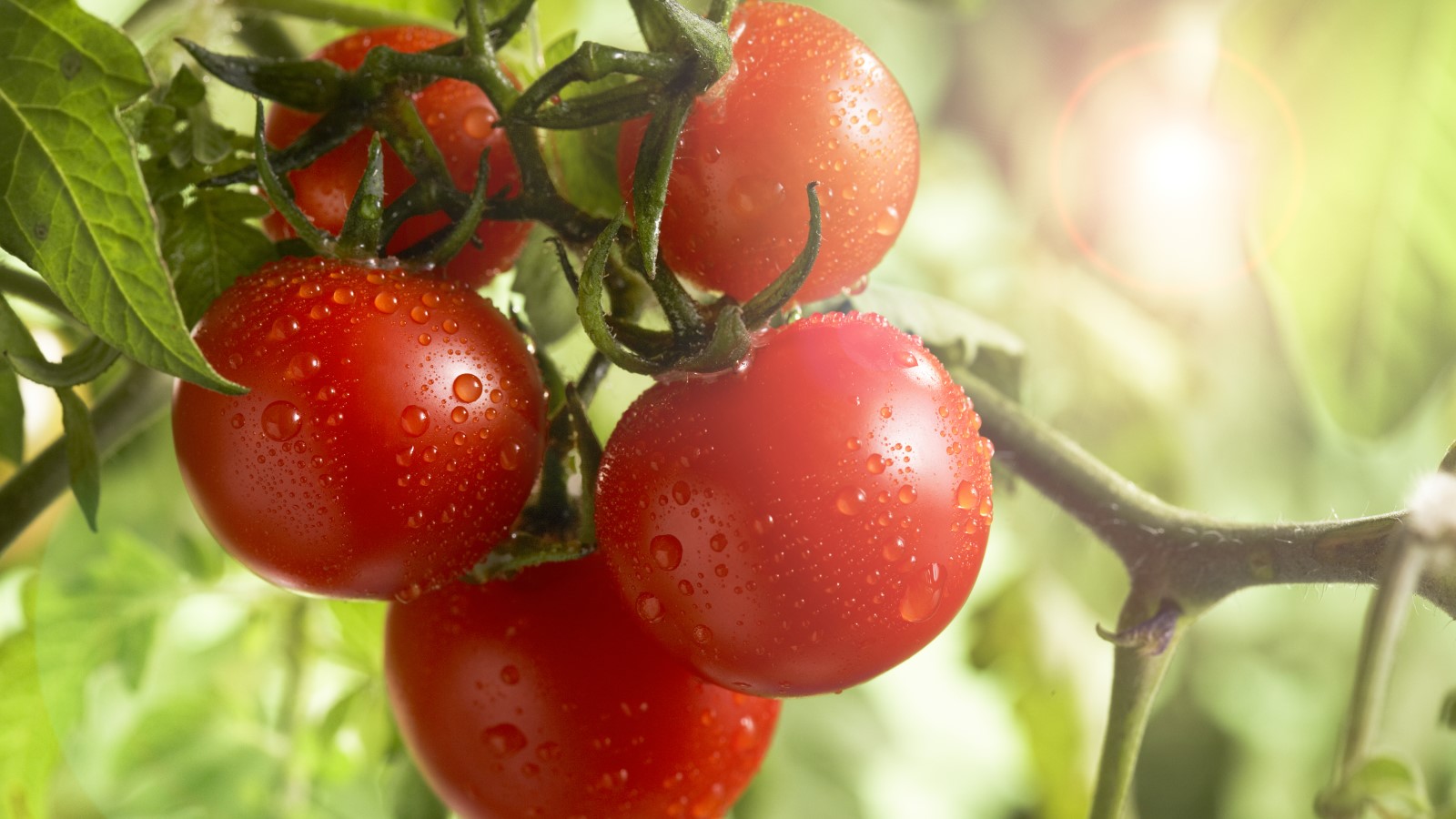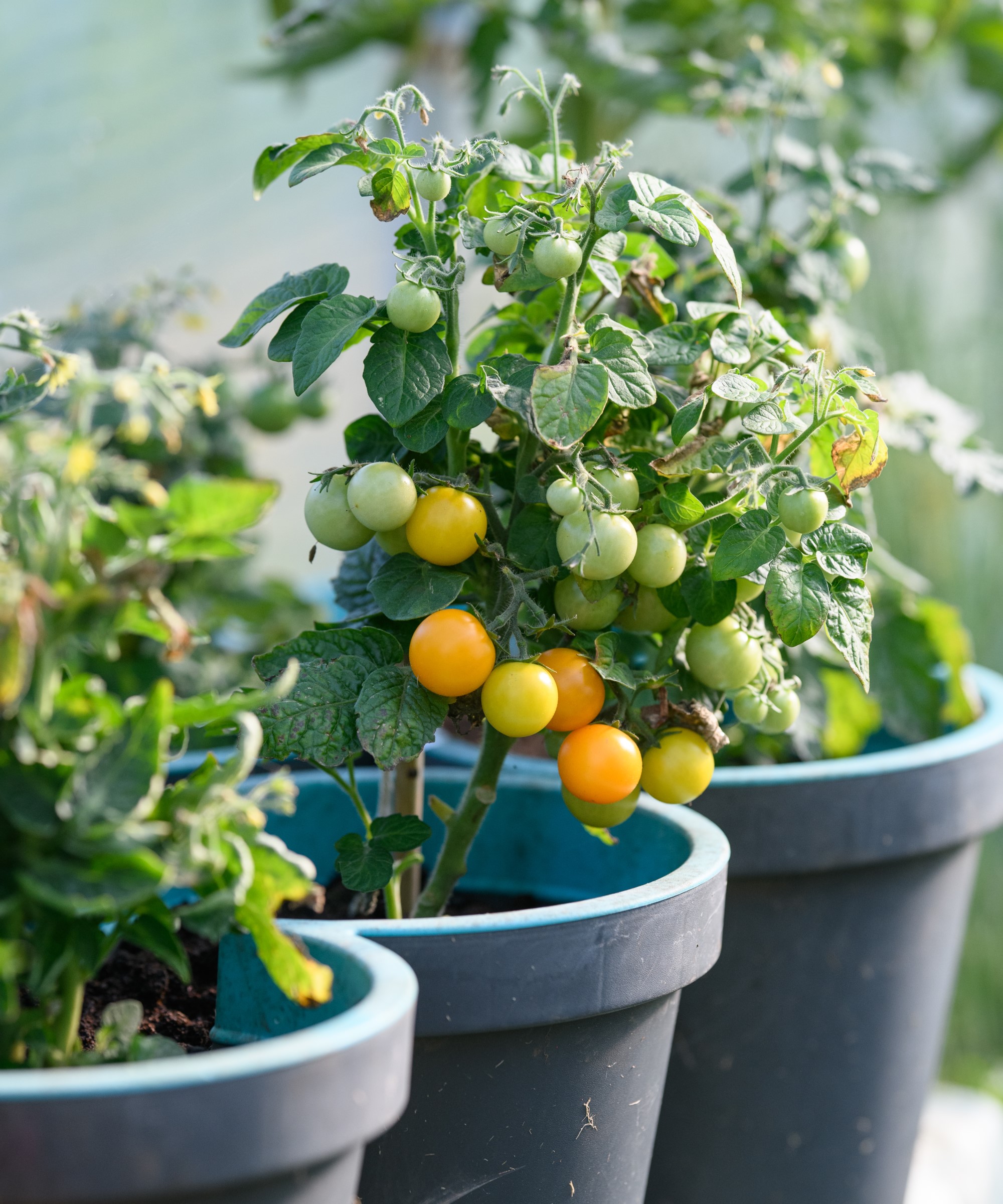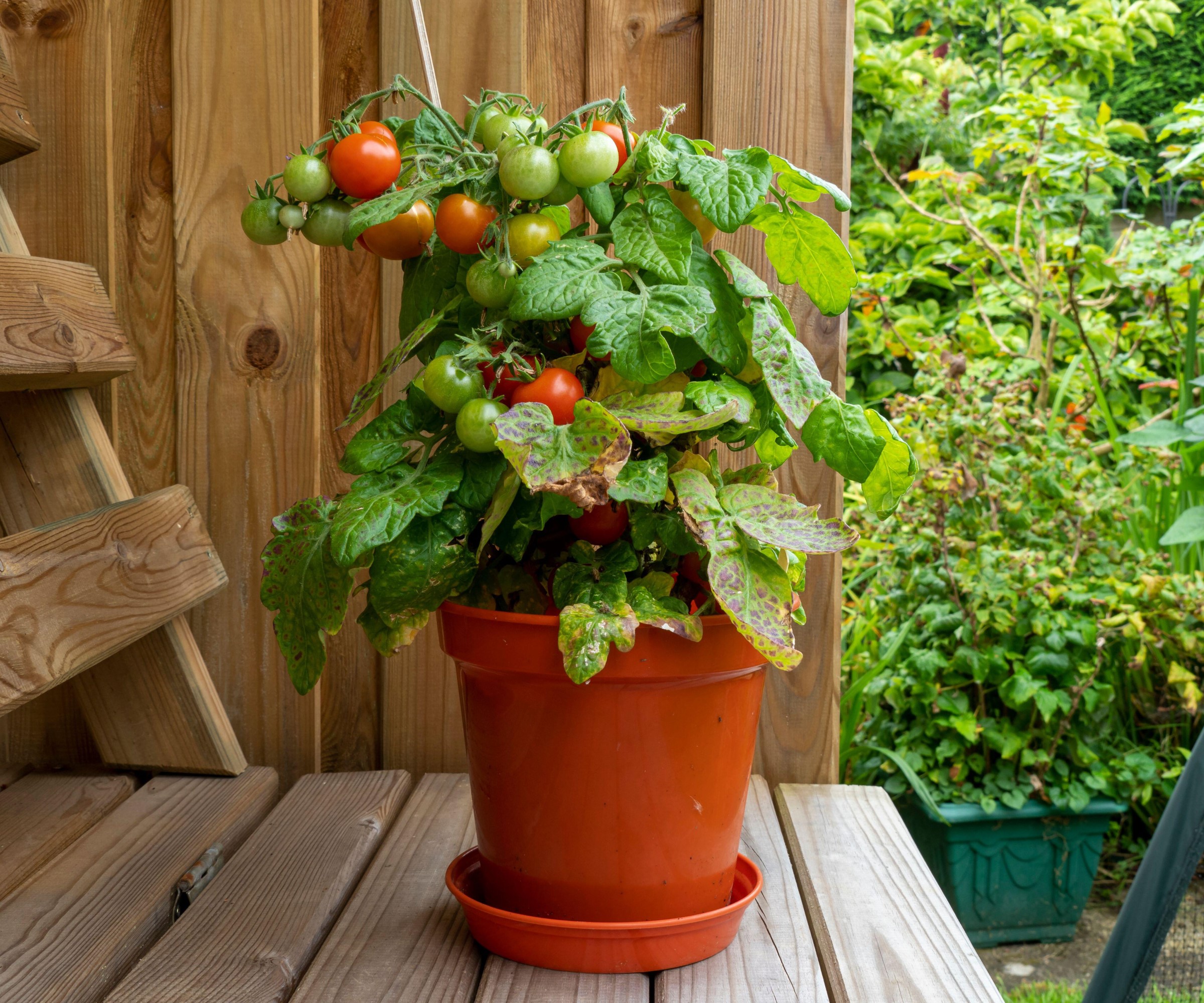How to grow tomatoes in pots – an expert vegetable grower reveals their container tips
Insider tricks and tips on how to grow tomatoes in containers, including how to pick the right type of pot and tomato variety to guarantee success


Tomatoes are a fantastic crop to grow in pots and are massively popular with gardeners worldwide. They are simple to look after and offer a huge array of different shapes, sizes, and flavors to discover.
Growing tomatoes in pots has a range of advantages to discover, including more control and convenience. It also opens up the chance to grow tomatoes if you have limited space or even no access to a garden.
If you want to know how to grow tomatoes in pots then you do need to think about the best pot size, compost and varieties for containers. In my time as a kitchen gardener I grew tomatoes in the ground and in pots – I was a fan of the fact that with pots I could control the watering and feeding of individual plants.

Tomatoes in pots need 6-8 hours of direct sunlight daily
Benefits of growing tomatoes in pots
There are many advantages to growing tomatoes in pots – they can be perfect for small vegetable garden ideas and they do only require a small amount of extra maintenance than plants grown in the ground.
It also opens up the range of possibilities and also allows you a greater degree of management when it comes to your plants. If you are thinking about starting a vegetable garden, then it might pay to consider whether you would rather grow your tomatoes in the ground or in pots.
Richa Kedia, a gardener for over 12 years and the editor at Nurserylady, echoes the sentiments that millions of people have that ‘there's nothing more satisfying than watching your plants grow and produce delicious fruit’. She reckons there are many reasons why growing tomatoes in pots is a great option, saying: ‘One of the main advantages is that it allows you to grow tomatoes even if you don't have a lot of outdoor space. That makes it a great option for apartment dwellers or people with small yards.
‘Another advantage is that it gives you greater control over the growing environment. You can choose the best soil, fertilizer, and watering schedule for your plants. Plus, you can move the pots around to take advantage of different amounts of sunlight or to protect your plants from harsh weather conditions.’
Being able to choose the soil, watering, and feeding, means you are able to create the perfect environment for tomato plants and that should mean better growth and production of fruit.
Growing tomatoes in pots can also help avoid soil-borne diseases that may be in the backyard soil and affect other potential vegetable garden ideas. The containers can be elevated and this is advantageous as it can prevent waterlogging and improve air circulation, key aspects to help avoid root rot and fungal infections.

Cordon types of tomatoes will need supports in their pots
Choosing the right pot for your tomatoes
Tomatoes are perfectly suited to growing in pots, providing you can give them a large and deep container in which to succeed and the right amount of heat and sun that the plants thrive for.
The containers can be made of terracotta, plastic, stone, or clay, while tomato plants can also grow happily in the likes of grow bags or hanging baskets.
The perfect size pot or container is going to depend on a variety of factors, including the space available and the variety of tomato you are growing.
Emily Jones, tomato grower for over 30 years and founder of Tomato Mentor, advises that a 5-gallon pot is ‘considered the minimum’ for growing tomatoes. However, larger varieties may need 10- or 15-gallon pots due to their mature size and large root systems. A 5-gallon pot tends to have a diameter of around 12 inches and an example is the Viagrow VHPP500-10 Round Nursery Pot available at Amazon.
‘Using a pot that is too small can lead to stunted growth, poor fruit production, and increased susceptibility to pests and disease. Conversely, using a pot that is too large can lead to over-watering and can make it difficult for the plant to absorb nutrients from the soil,’ warns Emily.
‘When selecting a pot for your tomato plants, be sure to choose one with adequate drainage holes to prevent waterlogging, and fill it with a well-draining potting mix that contains a good balance of organic matter and nutrients.’
The smaller the pot the more often it will have to be watered and also the material of the pot will affect how regular it needs watering. For example, terracotta pots dry out quicker than plastic or glazed ceramic counterparts and will need watering more often. Pot choice is always a crucial factor in any vegetable container garden as it can affect how much time you need to spend watering crops.
Tomato plants can also be grown in hanging baskets that are at least 18 inches in diameter and ideally one that can hold 5 gallons of soil.

Emily has been growing tomatoes for more than 30 years, and she founded the blog Tomato Mentor as a way of helping others to improve their growing methods. She regularly writes about everything from watering tomato plants and common tomato pests to the best growing techniques people should use in their own space.

Cherry tomatoes are the most popular for growing in pots
How to plant tomatoes in a pot
If you want to know how to grow tomatoes in pots, then the planting method is very simple and there is very little equipment required.
- To plant tomatoes, take your chosen pot and fill it to within an inch of the rim with a good multi-purpose compost. Mix a handful of homemade compost into the soil to provide extra nutrients and improve drainage.
- Whether you have grown plants from seed and are transplanting tomato seedlings, or have bought plants from a garden center, you should plant tomatoes once they are around 9-12 inches tall.
- Make a large hole in the compost, place the root ball of the tomato plant in, and fill it with the soil – making sure to firm the plant in well.
- Water well and keep the soil moist, but avoid it being waterlogged.
- Place the pot in a sunny spot, ideally one that gets at least 6-8 hours of direct sunlight daily.
Looking after tomato plants in pots
Watering tomato plants is an important maintenance requirement and it is essential to monitor the plant and water them regularly, especially during hot and dry weather. Emily Jones advises that ‘a good rule of thumb is to water your tomatoes when the top inch of soil feels dry to the touch’.
If you are growing tomatoes in containers, then regular fertilization is also essential as the plants are only limited to what is in the pot and cannot access nutrients from the surrounding soil. Tomatoes are heavy feeders and need regular feeding to grow and fruit. Feed them with a balanced fertilizer just after planting and, whey they start to set fruit, use a liquid tomato feed every week – such as the Expert Gardener Organics Vegetable & Tomato Food available at Walmart.
Just as with growing any tomatoes, make sure to regularly prune your tomatoes and remove side shoots and suckers from the plants. Also use supports, such as a stake or trellis, to keep the plant standing upright if you are growing a taller variety. Watch the fruits ripen and harvest tomatoes when they are a deep red color and come away easily from the plant with a gentle twist or tug.

Tomatoes growing in pots may need watering daily in hot weather
Best tomatoes to grow in containers
Most varieties of tomatoes are happy growing in pots, providing the container is large enough to hold the compost and water required. Compact and bushy varieties, also known as determinate tomatoes, are good for pots as they grow smaller yet you can still get a great crop. They will also trail over the edge of a pot and bring a decorative edge to any container garden or kitchen garden.
Joanna Turner, from Fiddle & Thorn, recommends: ‘Patio and bush tomatoes are the best types to grow as a beginner in a pot. They still grow to about 4 feet and produce plenty of fruit so are really great options.’
Veranda Red Hybrid and Super Sweet 100 Hybrid, both from Burpee, would be excellent varieties to consider growing in pots.
Cordon varieties, or indeterminate tomatoes, will also thrive in pots, however they do grow much larger and will need to be staked and supported as they grow. Most growers tend to opt for smaller cherry tomatoes to grow in pots, rather than large beefsteak tomatoes that need more support for the heavy fruit they produce.
I grew a range of tomato varieties in pots, however, they did tend to be cordon varieties as I was fortunate to have a large set up in which I could give individual plants a sturdy support within a greenhouse.
FAQs
How often do you feed tomatoes in pots?
Tomatoes growing in pots benefit from an application of general multi-purpose fertilizer just after being planted and before they start flowering. All plants need nitrogen, phosphorus and potassium – seen as a ratio of NPK on a plant fertilizer label – and a balanced feed will have these in equal parts, eg. 10-10-10. Once the tomato plants start to flower, start giving them a regular feed weekly with a dedicated tomato food that is high in phosphorus and potassium.
What is the best compost for growing tomatoes?
Any compost for tomatoes in pots needs to retain moisture and also be free draining. A multipurpose compost will contain all the nutrients required for tomatoes to grow into healthy plants. To add extra nutrients, add some garden compost or well-rotted manure into the lower half of the mix and, as well as boosting nutrients, this can also help with soil structure and also boost drainage. Always ensure any manure used in the garden is well-rotted, as fresh manure can kill plants as it is too high in nitrogen and salts.
Growing tomatoes in pots is a great way of cultivating tomatoes if you only have a small yard, deck or balcony garden. Even with only a small space, you can experience the pure joys of growing and harvesting homegrown tomatoes.
A real advantage is being able to directly control the watering and feeding of each individual plant. It means you can make sure that each one is getting all it needs to thrive and that effort should be rewarded with great crops.
Sign up to the Homes & Gardens newsletter
Design expertise in your inbox – from inspiring decorating ideas and beautiful celebrity homes to practical gardening advice and shopping round-ups.

Drew’s passion for gardening started with growing vegetables and salad in raised beds in a small urban terrace garden. He has worked as a professional gardener in historic gardens and specialises in growing vegetables, fruit, herbs, and cut flowers as a kitchen gardener. That passion for growing extends to being an allotmenteer, garden blogger, and producing how-to gardening guides for websites. Drew was shortlisted for the New Talent of the Year award at the 2023 Garden Media Guild Awards.
-
 How to clean a patio – 6 different methods, and when you must use a chemical cleaning agent
How to clean a patio – 6 different methods, and when you must use a chemical cleaning agentFrom manual scrubbing, natural solutions or calling in the pros, industry experts reveal the benefits and considerations of each method
By Andy van Terheyden Published
-
 Kris Jenner's favorite air fryer, the Ninja Crispi, is the perfect small kitchen solution – it deserves a place on the most compact of countertops
Kris Jenner's favorite air fryer, the Ninja Crispi, is the perfect small kitchen solution – it deserves a place on the most compact of countertopsKris approves of this compact yet powerful air fryer, and so do our own kitchen appliance experts, praising it for its multifunctionality
By Hannah Ziegler Published